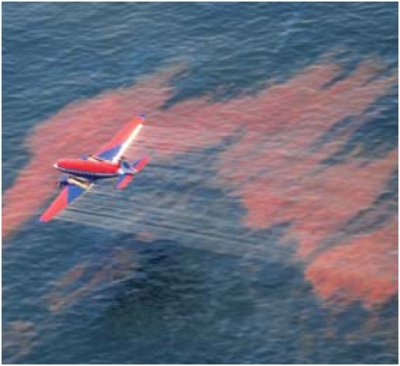Distinguishing oil spills from algal blooms
When observed from a boat or aircraft, many kinds of natural phenomena can be mistaken for oilon the water surface. Kelp beds, accumulations of jellyfish, and cloud (Clouds)shadows on the waterare sometimes mistaken for oil. Oil spill response experts call such phenomena “false positives.” Algal blooms are one kind of false positive. They are sometimes reported as oil on the water,even by trained and experienced observers. This document describes algal blooms and provides tips to help you avoid mistaking algal blooms for oil.
Contents
Noctiluca blooms
Algal blooms happen naturally when some kinds of microscopic algae multiply quickly to form visible patches on the water surface. Noctiluca is a common, non-toxic alga that forms red, tomato soup-like blooms in the Gulf of Mexico (Gulf of Mexico large marine ecosystem). A Noctiluca bloom can look similar to the reddish emulsifiedoil originating from the Deepwater Horizon wellhead.
Algal blooms can develop when nutrients become plentiful and other growing requirements (light (Photosynthesis), temperature, and salinity) are met. The Mississippi and Atchafalaya Riversbring nutrient-rich waterto the Gulf of Mexico (Gulf of Mexico large marine ecosystem), providing especially favorable conditions for blooms of Noctiluca and other species of algae from spring until the hurricaneseason.
Distinguishing Noctiluca from oil
If You’re Observing From a Vessel, Aircraft, or the Shore
 Red tide (algal bloom). Credit: NOAA If you see a reddish patch on the water surface, look for these clues:
Red tide (algal bloom). Credit: NOAA If you see a reddish patch on the water surface, look for these clues:
- Pattern: A patch of oil tends to appear streaky, or oil may appear as rows of streamers. Algae and water weeds tend not to appear streaky, but instead appear as an amorphous mass. Oilthat has emulsified(mixed with waterto form an emulsion) typically either has no texture, or appears streaky.
- Sheen: If you observe a dark or reddish patch on the water surface from an aircraft or vessel, look for sheen around it. Sheen is a very thin film of oilon the water that may be brown, silvery, rainbow-colored, or transparent. Sheen is usually present around patches of thicker oil on the water. You may see small quantities of colorless, sheen-like biofilm around algal blooms, but oil usually produces stronger sheen. Any colored sheen indicates oil(though not all sheen associated with oil is colored).
- Nighttime luminescence: Noctiluca is bioluminescent: when gently shaken, it produces light from chemical reactions within its cells. Boat crews operating at night may observe glowing stripes or patches on waves, which indicate the presence of Noctiluca. Oildoes not produce light. It’s possible that in some cases in the Gulf of Mexico (Gulf of Mexico large marine ecosystem), spilled oil may be comingled with algal blooms.
If You Have a Water Sample
 Emulsified oil from the Deepwater Horizon appears as reddish streaks on the water. Credit: USCG Avoid direct contact with substances that could be crude oil, because oilon bare skin can cause mild skin irritation. However, if you have obtained a fresh water sample that you think could contain oil, here are two ways to tell whether the sample contains Noctiluca instead, without using a microscope:
Emulsified oil from the Deepwater Horizon appears as reddish streaks on the water. Credit: USCG Avoid direct contact with substances that could be crude oil, because oilon bare skin can cause mild skin irritation. However, if you have obtained a fresh water sample that you think could contain oil, here are two ways to tell whether the sample contains Noctiluca instead, without using a microscope:
- Pour some of the water into a shallow dish, and inspect it closely. Look for tiny transparent balls somewhat like fish eggs. These balls are very small, less than a tenth of an inch in diameter. If you see them, your sample probably contains Noctiluca, and what you’re seeing are the mature cellsof this tiny algae.
- Take your sample into a completely dark room. Let your eyes adapt for several minutes, and thenswirl your sample. Watch for small flashes of light. If you see them, your sample contains Noctiluca.
